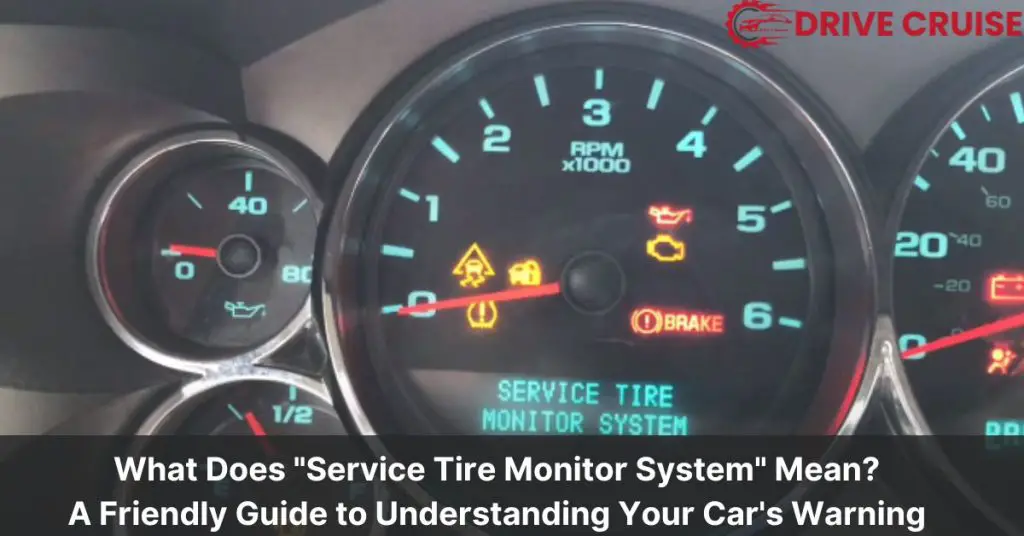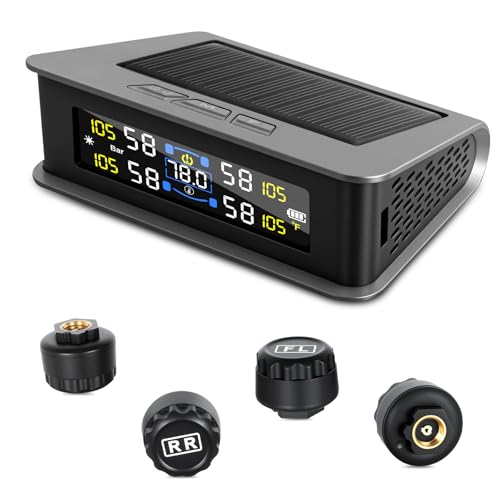Gazing at a dashboard filled with illuminated icons can be a nerve-wracking experience for any driver. The “Service Tire Monitor System” warning light is one of the most common icons that can appear on your dashboard. This warning light is usually an indication that your Tire Pressure Monitoring System (TPMS) requires attention. The TPMS is a safety feature that monitors the air pressure in your vehicle’s tires and alerts you when one or more tires are underinflated.
The “Service Tire Monitor System” warning light can come on for a variety of reasons, such as a tire sensor failure, flat sensor battery, or a sensor that needs reprogramming. In some cases, the warning light can also indicate a communication problem between the system and one or more tire pressure sensors. It is important to address this warning light promptly to ensure that your vehicle is safe to drive. In this guide, we will explore what the “Service Tire Monitor System” warning light means, what causes it, and how to address it.
Unveiling the TPMS: Understanding the System Behind the Light
If you’ve ever seen the “Service Tire Monitor System” light illuminate on your dashboard, you may have wondered what it means. This light is part of your vehicle’s TPMS, a safety feature that constantly monitors individual tire pressures. Understanding the core components of the TPMS can help you better maintain your vehicle’s tires and ensure your safety on the road.
Core Components
Sensors
The sensors are mounted on each wheel or inside the valve stem. They transmit real-time tire pressure data to a central control unit. These sensors are battery-powered and have a lifespan of around 5-10 years. If your TPMS light comes on, it could indicate a sensor failure or a low battery.
Control Unit
The control unit receives and analyzes pressure data from the sensors. It alerts the driver if any tire falls below a preset minimum pressure threshold. The control unit is typically located in the vehicle’s onboard computer system.
Dashboard Warning Light
The dashboard warning light illuminates to notify the driver of a TPMS malfunction or a significant underinflation event. If the light comes on, it’s important to check your tire pressures and inflate them to the manufacturer’s recommended levels.
Decoding the Warning: Why Does the “Service Tire Monitor System” Light Come On?
If you’re driving and notice the “Service Tire Monitor System” warning light illuminate on your dashboard, it’s essential to address the issue promptly. The light indicates that there’s an issue with the tire pressure monitoring system (TPMS), which is responsible for ensuring that your tires are at the optimal pressure level. Here are some of the most common reasons why the warning light comes on:
Underinflated Tire(s)
The most common reason why the “Service Tire Monitor System” light comes on is due to underinflated tires. The TPMS is designed to detect when a tire’s pressure is significantly below the recommended level, which can impact handling and safety. If the light comes on, you should check the pressure in all of your tires and inflate them to the recommended level.
Faulty TPMS Sensor
Another reason why the warning light may come on is due to a faulty TPMS sensor. A malfunctioning sensor can transmit incorrect data or stop sending signals altogether, which can trigger the warning light. If you suspect that a faulty sensor is the issue, you should take your vehicle to a professional to have it diagnosed and repaired.
Low Sensor Battery (for battery-powered sensors)
TPMS sensors in some vehicles utilize batteries that eventually wear out, leading to a loss of signal and the warning light coming on. If the light comes on and you have battery-powered sensors, it’s possible that the battery needs to be replaced. You can take your vehicle to a professional to have the battery replaced or replace it yourself if you have the know-how.
System Malfunction
In rare instances, the TPMS control unit itself might experience an internal issue, requiring professional diagnosis. If none of the above reasons seem to be the issue, it’s possible that there’s a malfunction in the TPMS system itself. In this case, you should take your vehicle to a professional to have it diagnosed and repaired.
Illuminated Light, What Now? Addressing the “Service Tire Monitor System” Warning
If you see the “Service Tire Monitor System” warning light on your dashboard, it’s important to address it promptly. Ignoring it can be dangerous and lead to further issues. Here’s what you can do to address the issue:
Check Tire Pressures Manually
The first step in addressing the “Service Tire Monitor System” warning light is to manually check the tire pressures. You can use a reliable tire pressure gauge to measure the inflation pressure of each tire, including the spare. Make sure to inflate any underinflated tires to the recommended PSI level specified in your vehicle’s owner’s manual or door jamb placard.
If you’re unsure about how to check your tire pressures, you can visit a local auto parts store like AutoZone, where they offer free tire pressure checks and can provide guidance on how to inflate your tires to the correct level.
Reset the TPMS (if applicable)
After inflating your tires to the recommended PSI level, you may need to reset the TPMS system. Consult your owner’s manual for specific instructions on how to do this. The process often involves a button sequence or using a scan tool.
If you’re unsure about how to reset the TPMS system, you can also visit a local auto parts store or seek help from a qualified automotive technician.
Seek Professional Help
If the warning light persists after inflating the tires and resetting the TPMS, it’s important to seek help from a qualified automotive technician. They can diagnose the issue, whether it be a faulty sensor, a low battery (in applicable systems), or a more complex TPMS malfunction.
Ignoring the “Service Tire Monitor System” warning light can be dangerous, so it’s important to address it promptly. By manually checking your tire pressures, resetting the TPMS (if applicable), and seeking professional help if needed, you can ensure your vehicle is safe to drive and prevent further issues from occurring.
Prevention is Key: Maintaining a Healthy TPMS
Your vehicle’s Tire Pressure Monitoring System (TPMS) is a crucial component that helps keep you safe on the road. Regular maintenance of your TPMS is essential to ensure it functions optimally. Here are some practices to keep your TPMS functioning optimally:
Regular Tire Pressure Checks:
Make a habit of checking your tire pressures at least once a month, even if the TPMS light isn’t on. You can check your tire pressure using a tire pressure gauge or by visiting your local mechanic. Maintaining proper tire pressure is essential to ensure optimal tire performance and fuel efficiency.
Seasonal Adjustments:
Tire pressure can fluctuate with temperature changes. Adjust tire pressures according to the manufacturer’s recommendations for the season. During the colder months, your tire pressure may decrease, while in warmer weather, it may increase. Proper tire pressure ensures optimal tire performance, improves fuel efficiency, and prolongs tire life.
Prompt Attention to Low-Pressure Warnings:
Don’t ignore the “Service Tire Monitor System” light. Address underinflation promptly to ensure safety and optimal tire performance. Driving on underinflated tires can lead to excessive wear and tear, decreased fuel efficiency, and even tire blowouts. Promptly addressing low-pressure warnings can help prevent costly repairs and ensure your safety on the road.
Tire Rotations and Replacements:
Maintain a regular tire rotation schedule as recommended by your vehicle’s manufacturer. This helps ensure even wear and tear, minimizing the likelihood of TPMS sensor damage during tire service. Additionally, it’s essential to replace your tires when they become worn or damaged. Worn or damaged tires can cause your TPMS to malfunction, leading to inaccurate readings and potential safety hazards.
Conclusion: A System for Safety
Maintaining proper tire pressure is crucial for safe driving. The “Service Tire Monitor System” warning light serves as a vital alert, reminding you to maintain proper tire pressure. The TPMS is a technology designed to monitor tire pressure and provide timely alerts to drivers. It enhances safety, prolongs tire life, and improves fuel efficiency.
The TPMS consists of sensors, communication protocols, and monitoring methods. TPMS sensors are installed in each tire and continuously measure the air pressure. When a tire gets too low, the alert goes off so you can fill it up with air. With most of the newer models, the TPMS light would come on and the infotainment system would tell you which tire is low.
Driving with a service tire monitor system light blinking on the dashboard is not safe. Since several issues can cause the car computer to trigger a service tire monitor system on Chevy Equinox and other car models, it can pose a bad omen. It may mean you have overinflated or underinflated tires, which can cause tire blowouts on the highway.
To address the warning light, you should first check the tire pressure and inflate or deflate the tires as needed. If the light persists, it may indicate a faulty sensor or a dead sensor battery. In this case, it is recommended to take your vehicle to a certified mechanic to diagnose and fix the issue.
Related Posts:











